Back in the EU at last!
After three months in Morocco with lots of ups and downs in this completely different culture, it feels like a blessing to be allowed to return to the EU. And so uncomplicated. Late in the evening at the border between Spain and Morocco in the Spanish enclave of Ceuta, the Spanish officials are particularly interested in our dog. Do we have the required rabies antibody titre test for him? Fortunately, we do! Without this, you are not officially allowed to (re-)import a dog from a non-EU country into the EU. And we were actually asked for the relevant documents both at this border and at the Turkey-Bulgaria border in autumn 2022. It is therefore worth adhering to the regulations correctly here. Without the aforementioned test and valid (rabies) vaccinations, there would be major problems when entering the EU!
We want to get back to the European continent as quickly as possible and take a ferry from Ceuta to the Spanish mainland the very next morning.
How privileged we are, simply because of our German citizenship! We realise this once again here. Changing countries and continents so easily, without a visa, without a long wait, without any worries… it really is a blessing that we really appreciate.
Back on European soil, Spain feels like paradise from the very first days!
Not since our weeks in Hungary in August 2021 had it been this clean, i.e. rubbish-free! Clean car parks, litter-free roadsides, clean hiking trails and picnic areas. Nobody here behaves so inconsiderately and simply leaves their picnic rubbish on the spot. It is usually a matter of course to take your packaging etc. back home with you. A real blessing that allows us to simply enjoy and take a deep breath!
The first encounters with Spanish compatriots also reawaken our almost forgotten joy in everyday short contacts. The first time we go shopping, we are kindly helped to buy a suitable SIM card for the Internet. And two people even happen to be able to do this in German! This is very helpful because, as is almost always the case, virtually nobody here speaks English and our Spanish is not yet good enough for concrete communication. And this help is purely out of kindness. Nobody asks or expects anything in return, let alone payment. Paradise! We can even have a snack after shopping in the car with the door open in the middle of a residential street. No one holds out their open hand to us as we pass by or wants to demand a made-up parking fee. These are the sunny sides of Western European paradise…
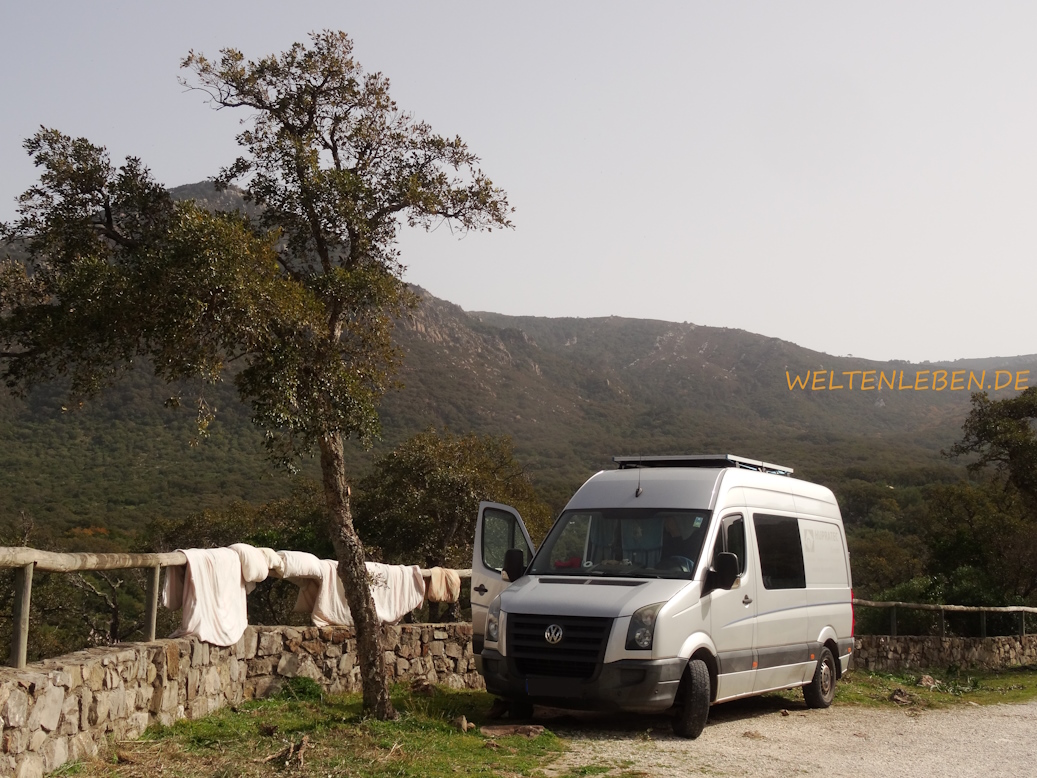
Take a deep breath and feel good in a clean environment! 🙂
We could hardly imagine anything about Spain before. Now we’re in Andalusia, in the very south, and just want to see what there is to discover here. And it turns out that there is quite a lot!
Exciting and varied landscapes, very mountainous and hilly, even not far from the coast.
A magnificent and diverse culture, which can be seen in very pretty smaller and larger towns and cities, and whose architecture is a constant reminder of the historical past: Andalusia was occupied by the Moors for a long time and was therefore under Arab and Muslim rule from the 8th to the end of the 15th century! Even the name Andalusia originates from this period: “al-Andalus”. The Romans also left their mark and we will visit two exciting archaeological sites (more on this in the next post :-)).
Countless nature parks, some of which even merge into one another, invite you to go hiking and discover nature. There are also countless hiking trails in every nature park, in all levels of difficulty and imaginable lengths: From leisurely one-hour circular walks to summit trails and long-distance hiking trails over hundreds of kilometres.
Click on the following gallery for some nature park highlights:
Only cycling on your own turns out to be difficult: outside the mountainous nature parks, there seem to be almost only private areas in fields, meadows and forests and these are almost always fenced in and the gates are secured with locks. When we come up against such an obstacle and end up having to push, sweat and swear our bikes across a muddy field to get back, we are immediately approached by two men in a car at the end of the field. They don’t speak English either, but the gestures are unmistakable: “You can’t just walk across here! A hunter could shoot you!”… because hunting is very important in Andalusia, at least according to the countless signs on fences.
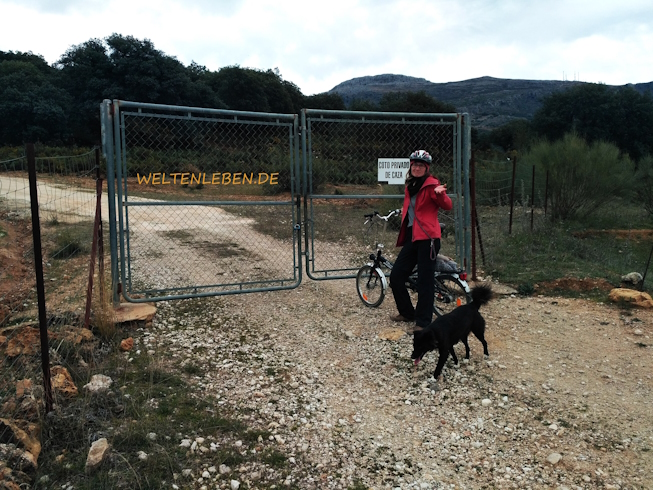
Private land in Andalusia can be fenced off over a wide area. Unfortunately, this means that the usual freedom of movement on country lanes is often not guaranteed
In the end, Andalusia kept us under its spell for a whole 2.5 months. And despite often changing locations every day, we only manage to explore the western part, because there is simply so much to discover!
Right after our very first night on European soil, our eyes go wide in the morning: griffon vultures! Over there, over the next hill, they’re circling, aren’t they? Our binoculars confirm it. And it’s not just four or five of them, as we’ve already seen at close quarters in Armenia. There are several clusters of over 20 animals in all directions. We soon realise: Andalusia is the realm of the griffon vulture! Several times we see huge flocks with hundreds of birds travelling up and down in clusters!
One hike in particular will always remain in our memories. In the first nature park we visit, the “Parque Natural de los Alcornocales” – the “Nature Park of the Cork Oaks” – we climb a smaller mountain peak, still unaware of the natural highlight we will experience there: Hundreds of griffon vultures, very close! They fly by just above us, only a few metres away, and sit just as close below us, resting on rugged rocky ridges. In the end, we are able to enjoy our summit snack surrounded by these incredibly majestic animals, while we simply feel great gratitude and humility in our hearts as well as excitement.
A few impressions of this experience can be seen in the following gallery:
We do a little research and find out that there is a reason why there are only significant populations of these gentle giants left in Europe in Spain. They really only feed on carrion and are therefore dependent on it. The carcasses of free-grazing farm animals probably make up 3/4 of their diet. In the neighbouring countries of Portugal and France, the carcasses of free-grazing sheep, goats and cows have mostly been cleared away for around 25 years and so the griffon vultures there literally have nothing left to eat. In Spain, of course, dead animals have been allowed to be left lying around again for 12 years now after strong efforts by animal welfare organisations there. In addition, there is also permission to release animals that have died in (mass) livestock farming into the wild in a controlled manner, thus helping the griffon vultures to feed. As a result, the population in Spain has now grown to several tens of thousands of breeding pairs.
In addition to the many magnificent nature parks, we also visit small towns and villages that are well worth seeing and turn out to be real gems.
In Ronda, a spectacular gorge with a waterfall divides the town into two halves and the old towns of Priego de Cordoba and Antequera, for example, are full of pretty alleyways and one great building after another. We can hardly get enough of it and are simply amazed by so much aesthetics.
Come and enjoy the beautiful old towns with us in this gallery:
Antequera is not only worth a visit because of its old town: a nature park with unique rock formations is located not far from the town. The “Paraje Natural Torcal de Antequera” is also home to the Spanish ibex, which we can even admire on site without any fear.
You can accompany us on two hikes through “El Torcal” in the following gallery:
And Antequera itself has another exciting sight in store: The so-called dolmen site or “Sitio de los Dolmenes de Antequera”! With an age of around 5,500 years, they date back to the Stone Age and were used as a sacred site and meeting place as well as partly as graves. Huge blocks of stone weighing several tonnes were moved using the simplest means available at the time and erected according to a specific procedure. Finally, the sites were covered with an equally massive stone ceiling and covered with earth.
Admission to the three dolmens is not only free, but a beautifully designed museum, including an animated film about the creation of the sites, also provides a vivid background to the visit.
Click on this gallery for an impression including a short journey through time:

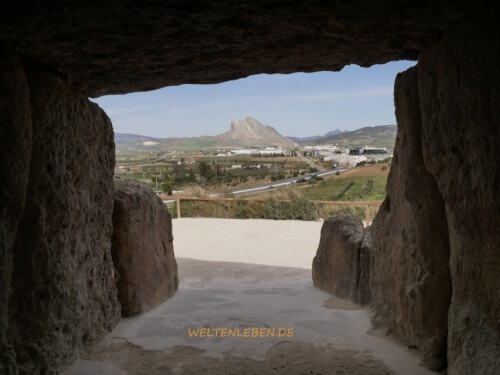
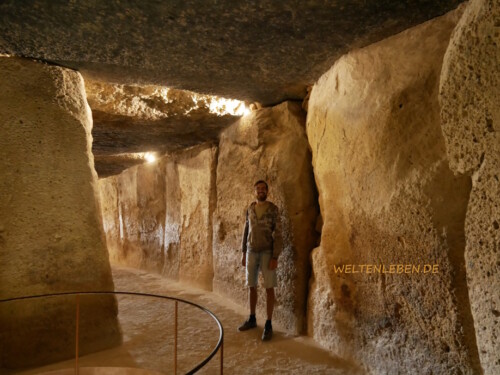
It is already the end of March when we finally reach Cordoba. With just under 320,000 inhabitants, this is the third largest city in Andalusia. It is best known for the so-called “Mezquita”, or officially “Mezquita-Catedral de Cordoba” – a beautiful, huge building built on the site of former Roman temples a beautiful, huge building that was built on the site of former Roman temples and a Visigothic cathedral and was originally constructed in the 8th century as a huge mosque. At around 23,000 square metres, it is still one of the largest former mosque buildings in the world today! It was finally converted back into a church in the 16th century. This building therefore combines a variety of different cultural, religious and architectural styles. And great thing is that a visit is possible free of charge at a certain time in the morning! We took advantage of this opportunity and travelled around the Mezquita with surprisingly few other visitors. This experience is all the more pleasing when we see the queue of people in front of the ticket office on our way out, which is already several metres long 😉
Visit this unique building, which is also a UNESCO World Heritage Site, with us in the following gallery:
Cordoba is not only worth a visit because of its mosque-cathedral! There is a lot to discover in the historic centre, which extends over 3 different parts of the city. We found the former “Jewish quarter”, which is heavily marketed to tourists, to be the least spectacular part. In addition to some sightseeing and a leisurely stroll through the various neighbourhoods, we also indulged in culinary delights during our three days there. We try the much-loved “churros con chocolate” in Spain for the first time: Deep-fried, slightly salty dough snakes, baked hot and served fresh with thick hot chocolate. Mmmmmm!
Click to open the gallery with more colourful impressions of Cordoba:
While it was still very cloudy in February and rather cool with 12 degrees during the day and up to 4 degrees at night, spring is clearly noticeable from mid-March. Temperatures climb up to 20 degrees on some days and in Cordoba it’s a good 25 degrees! It’s a bit surreal. On the one hand this heat, on the other many trees still have no leaves at all. Instead, flowers are competing with their colours and scents on various trees! Spring and summer seem to co-exist here for a few weeks.
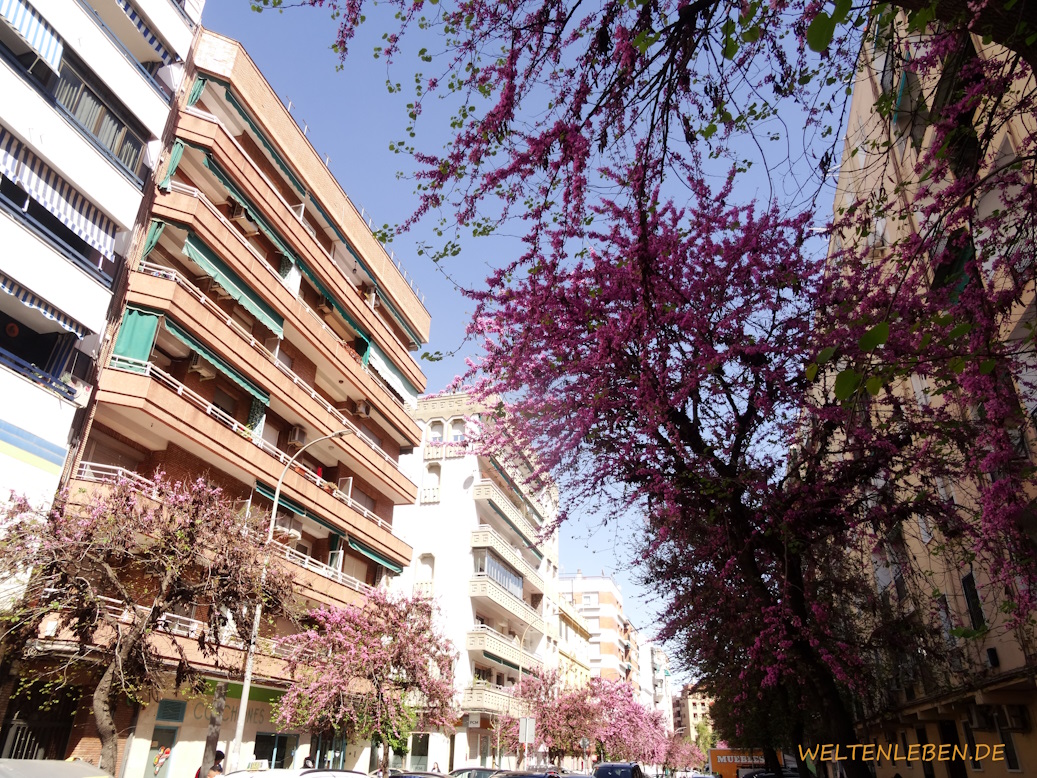
It’s fragrant and blooming!
And we are yet to reach the hottest region of Andalusia around Seville…
Look forward to more exciting discoveries including very special Easter celebrations and many more Andalusian highlights in the next post!
Until then, best regards from weltenleben.de
Sophia and Chris















































